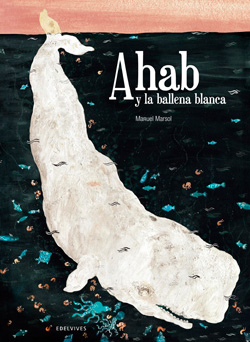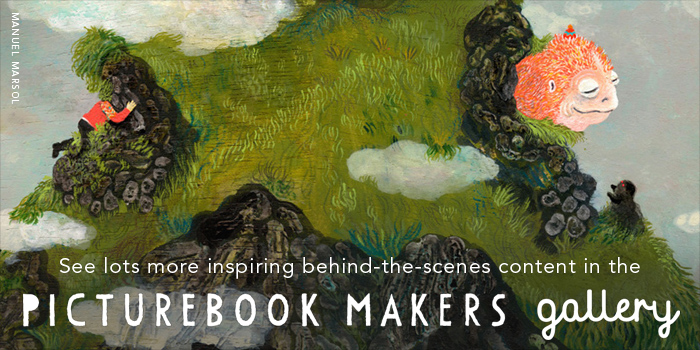< Back to posts
Manuel Marsol
Spain

Manuel Marsol, who grew up in Madrid, has degrees in Advertising and Audiovisual Communication, and a postgraduate diploma in Children's Book Illustration. He's featured in the Bologna Illustrators Exhibition twice, and he won the V Catálogo Iberoamericano de Ilustración and the Edelvives International Picture Book Award.
In this post, Manuel talks about the creation of his stunning debut picturebook, ‘Ahab y la Ballena Blanca’ (Ahab and the White Whale). This poetic and beautifully illustrated story was inspired by ‘Moby Dick’ and by Manuel's lifelong fascination and love for the ocean.
Manuel: ‘Ahab y la Ballena Blanca’ (Ahab and the White Whale) is inspired by ‘Moby Dick’, and tells the story of a sailor obsessed with finding a whale that is, paradoxically, always in front of him. Ahab thinks that what he has in front of him is a strange warm iceberg, but in reality he is touching the great white whale. This is a story about obsession and the mysteries of the sea.
As a child I would spend the summer on the Mar Menor and dive for hours with my sister, surrounded by fish and jellyfish, experimenting with a mix of fear, excitement and happiness. Then we would paint everything we had seen underwater with our parents. Onto the paper we would glue seashells and even dried seahorses we found on the sand.
‘Moby Dick’, a book I really love, was the excuse to make a book related to those memories about the fantastic and everyday side of the sea, which sums up the mystery of life quite well: it is within our reach and we admire it, but it holds things that we will never understand, and that scare us. Beauty and fear. It may seem calm on the surface, but what battles are fought down there? When I was a child, the sea was a door to the unknown; what was the difference between a jellyfish infestation and an alien invasion?
Memories are not enough to tell a story. This is where the difficulties start! I believe firmly in the capacity of thinking through drawing. At first, I am not sure where I am going, setting out on a series of emotions, landscapes or atmospheres. To me, this is absolutely essential to the development of the story. For example, I began drawing a giant white whale rising to the surface, like an island with palm trees, which is another engraved childhood memory about a book we had at home: ‘Sol Solet’ by the theatre group, Els Comediants (recipient of the Critici in Herba award at the Bologna Children's Book Fair in 1985).
‘Sol Solet’, by Els Comediants, published by Edicions de l'Eixample, 1985.
Then I drew a cliff in the shape of a whale's head. At that point I still had no idea what the story would be. I kept on drawing many scenes of whales ‘hidden’ in the landscape, along with loose ideas that did not fit in what would later become the picturebook. But some other ideas are almost intact in the final version.
Then I thought it would be fun to see Ahab obsessed with searching for something he always had right under his nose. And so I realised the connection between one of the biggest themes in ‘Moby Dick’ (obsession) and what I was doing. Besides, it was linked to my creative process: we are often sitting so close to the solution that we cannot see it. And sometimes, a few steps back from the fog are enough to realise that it is actually a whale.
‘Accidents’ are a very important part of my work, but there is also plenty of research: I read monographs on ‘Moby Dick’, I rewatched John Huston's movie, reread passages from the book and references on the internet... Everything contributes to producing a sudden spark. Some people work with a very clear idea of the story they want to tell and how they want to tell it before even starting. In my case, I let my obsessions, intuition and research do the first part of the work.
The rest is rational; everything must make sense, and that is where insecurities and obstacles come in. There is no straight path. It is a matter of winning small battles, of making mistakes until you correct them, be it because you saw them or because your editors, your girlfriend or your friends saw them.
One of these battles is the tone of the illustrations. This is a task I begin before having a story, whether a test or a potential final illustration. It is very hard to visualise the rest of the book graphically until you find that one image that you know is the right one. I had no doubts after I had digitally retouched this one:
I like to try things out in Photoshop after scanning (this drawing was done on paper with Chinese ink, collage, watercolours, pencils and plastic emulsion paint). I like to change the levels, the tone, or switch the colours. Suddenly, my own drawing had surprised me, as if I had not created it myself! This is why I always say that we must be open to the accidents in the process – to things we had not foreseen – because they provide a freshness that is impossible to achieve intentionally. When I saw that night with its azure trees, another rush of childhood memories came back to me about pirates and the sea. Fear and fascination. Like the sense of mystery I felt when I played Monkey Island on the PC.
‘The Secret of Monkey Island’, developed and published by Lucasfilm Games, 1990.
For the final illustration, I just modified the character and enlarged it to a double-page spread.
After this discovery, many nocturnal or underwater illustrations were conceived in reverse. I mean, I thought of which colours were necessary so that when I inverted them I would get the desired result. For example, if I wanted a red octopus, I drew it in blue. The original drawings look like they were made by someone who is colour-blind!
Many good ideas only show up while you are facing specific issues. In the first depictions of the Kraken, who was to steal Ahab's leg, I wanted to make the intertwining tentacles stand out, taking up the entire page. But I did not want it to look dramatic. So I needed a fun idea, and I thought I could make the octopus look like a giant hand. Now it was an octopus with a sense of humour. I drew it twenty times, changing tentacles here and there, until the image worked as a hand without stopping being an octopus. The upside is that during the process, enriching details tend to pop up, like giving it an eel-ring!
I presented the text (another of the picturebook's big battles) as a project for the Edelvives International Picture Book Award, and it was different to the one in the final book. This was because months passed between me receiving the award and the final artwork delivery. During that time, I had the chance to rework it, but it wasn’t until almost the day before delivery that I rewrote it from beginning to end! The story was the same; the problem was the voice I had used, which was not quite right. Originally, someone else was telling us Ahab’s story. The captain said things out loud; he complained and grumbled. You might know the feeling that when something doesn’t work, you can just sense it. You might not know exactly how to fix it, but you know that something is not right. And when you finally put your finger on it, and you know what to do, you feel like screaming for joy.
So the text was too flashy, every line wanted to be funny, and it often repeated what we already saw in the images. It did not fit with the poetry of the illustrations; they asked for peace, they wanted us to observe the infinity of the details, and to think. I began by reducing the amount of text, but it was not enough. One morning, I thought, I will tell the story in the first person, as if I was Ahab. And suddenly the screaming gave way to the silence – that is, the mystery, the interpretations and the multiple readings. I rewrote it in one morning. It almost wrote itself, and this happens after a lot of work: everything tidies itself up without warning! I had actually been rewriting it in my head for a long time.
Regarding the colour, my reference was John Huston's film of ‘Moby Dick’. I liked the classical touch it achieved with such a limited palette. Despite that it is in colour, we get the feeling we are watching a black-and-white movie.
‘Moby Dick’, directed by John Huston, 1956.
As I moved further through the process, together with my editors, we realised it would be interesting to add some amazing glints of sea life colour. I think the picturebook has a good balance between the classical and, let's call it ‘hallucinogenic’ sides of the sea floor.
The evolution of the work can be seen in the scene inside the whale's belly. The original was practically black and white:
And this is how it finally looks in the book:
Many people ask me about the textures. These are inspired by the chipped paint on fishermen's boats, seaweed on sunken bricks, fish scales, seashells, etc. As a child I would stare at the seaweed and almost touch the sea floor with my nose. I also remember the feeling of holding a fish in my hand: the texture of its raspy skin.
On the other hand, some of the textures are also greatly influenced by an abstract painter from Madrid called López-Soldado, as I was brought up surrounded by his paintings. I spent a few months painting with him and he taught me some of his techniques, based on mixtures that give random results that have always interested me (like oil with acrylic, water with Chinese ink, etc).
Paintings by López-Soldado.
His amazing world fascinated me to the extent of running my hand over his paintings. This is why I like it when I see people running their hands over the pages of my book, as if they expect to feel something coarse – like the feeling I had as a child when I held a fish in my hand.
Illustrations © Manuel Marsol. Post translated by Gengo and edited by dPICTUS.
Ahab y la Ballena Blanca /
Ahab and the White Whale
Manuel Marsol
Edelvives, Spain, 2014
An original and poetic interpretation of Herman Melville's classic novel, ‘Moby Dick’.
Captain Ahab is determined to find the great white whale, and will not stop until he finds him. He sets off on an epic adventure full of excitement and danger: sea monsters, inexplicably hot icebergs, caves inhabited by cannibals... but no sign of the great white whale.
The sea is a mystery.




























